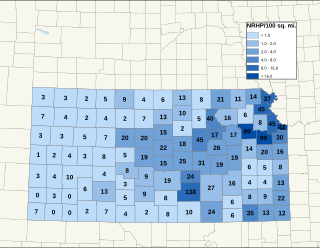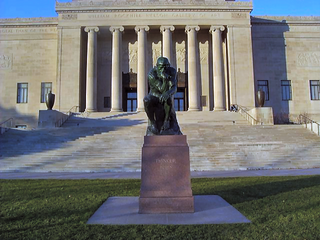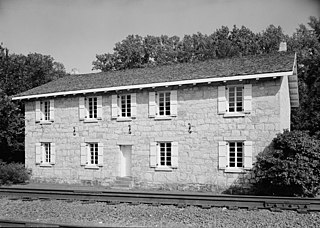
Topeka is the capital city of the U.S. state of Kansas and the seat of Shawnee County. It is along the Kansas River in the central part of Shawnee County, in northeast Kansas, in the Central United States. As of the 2020 census, the population of the city was 126,587. The Topeka metropolitan statistical area, which includes Shawnee, Jackson, Jefferson, Osage, and Wabaunsee Counties, had a population of 233,870 in the 2010 census.

Hurtsboro is a town in Russell County, Alabama, United States. At the 2010 census the population was 553, down from 592 in 2000. It was founded in 1857 as Hurtsville and named for Joel Hurt, Sr.. A railroad spur from Columbus, Georgia was completed the next year. It was incorporated in 1872 and in 1883 the town name was changed to Hurtsboro.

Gilbert Stanley Underwood (1890–1960) was an American architect best known for his National Park lodges. Born in 1890, Underwood received his B.A. from Yale in 1920 and a M.A. from Harvard in 1923. After opening an office in Los Angeles that year, he became associated with Daniel Ray Hull of the National Park Service. This led to a commission with the Utah Parks Company of the Union Pacific Railroad which was developing the parks in hopes of producing destinations for travelers. During this time Underwood designed lodges for Cedar Breaks National Monument, Zion National Park, Bryce Canyon National Park, and the North Rim of the Grand Canyon National Park. His surviving Utah Parks Company buildings are considered exceptional examples of the Rustic style of architecture, and are all listed on the National Register of Historic Places. In addition, Underwood was contracted to design Yosemite National Park's The Ahwahnee, also on the National Register and probably his greatest triumph in the Rustic style.

Topeka High School (THS) is a public secondary school in Topeka, Kansas, United States. It serves students in grades 9 to 12, and one of four high schools operated by Topeka USD 501 school district. In the 2010–2011 school year, there were 1,840 students enrolled.

There are over 1,400 buildings, sites, districts, and objects in Kansas listed on the National Register of Historic Places in Kansas. NRHP listings appear in 101 of the state's 105 counties.

The Kansas State Capitol, known also as the Kansas Statehouse, is the building housing the executive and legislative branches of government for the U.S. state of Kansas. Located in the city of Topeka, which has served as the capital of Kansas since the territory became a state in 1861, the building is the second to serve as the Kansas Capitol. During the territorial period (1854–1861), an earlier capitol building was begun but not completed in Lecompton, Kansas, and smaller structures in Lecompton and Topeka were where the territorial legislatures met.

The Blaine House, also known as James G. Blaine House, is the official residence of the governor of Maine and his or her family. The executive mansion was officially declared the residence of the governor in 1919 with the name "Blaine House". It is located at Capitol and State streets in Augusta, across the street from the Maine State House.
The Indiana Governor's Residence is the official home of the family of the governor of Indiana and is located in Indianapolis, Indiana. In use since 1973, it is the sixth official residence of Indiana's governors. The current tenant is Governor Eric Holcomb.
The Wyoming Governor's Mansion is the official residence of the governor of Wyoming. The current mansion was built during 1976 in Cheyenne.
Thomas Wilson Williamson was a Kansas architect who specialized in designing school buildings in Kansas, Iowa, and Missouri.
The Topeka Capital-Journal is a daily newspaper in Topeka, Kansas owned by Gannett.

Wight and Wight, known also as Wight & Wight, was an architecture firm in Kansas City, Missouri consisting of the brothers Thomas Wight and William Wight who designed several landmark buildings in Missouri and Kansas.

The New Hampshire Governor's Mansion, known as "Bridges House", is the official residence of the governor of New Hampshire and the governor's family. Bridges House, located at 21 Mountain Road in Concord, the capital of New Hampshire, has served as the governor's official residence since 1969. Built in 1836, it was listed on the National Register of Historic Places in December 2005, and the New Hampshire State Register of Historic Places in July 2005.

The Old Louisiana Governor's Mansion, home of Preserve Louisiana, is located at 502 North Blvd. between Royal and St. Charles Streets in Baton Rouge and was used as Louisiana's official gubernatorial residence between 1930 and 1963; a new residence was completed in 1963. The Old Governor's Mansion was built under the governorship of Huey Long, its first resident. The building is reported to be inspired by the White House in Washington D.C. as it was originally designed by Thomas Jefferson. It is said that Long wanted to be familiar with the White House when he became president, so he had the White House duplicated in Baton Rouge. Some dispute this legend and simply say that the building is merely a fine example of a Georgian-style mansion.

The First Territorial Capitol of Kansas is the sole remaining building of the ghost town of Pawnee, Kansas. The city served as the capital of the Kansas Territory for five days before it was moved to present day Fairway, Kansas, and the town became part of neighboring Fort Riley. The building was the meeting place for the first elected Territorial Legislature in 1855. After falling into disrepair, the structure was restored in 1928 and today it serves as a history museum operated by the Kansas Historical Society and supported through The Partners of the First Territorial Capitol.

The Condit House is the Official Residence of the President of Indiana State University. Built in 1860 and bequeathed to the University in 1962, it is the oldest building on the campus. The home, an example of Italianate architecture, was the private home of the Right Reverend Blackford Condit and his family from 1862 until 1962. Condit's youngest daughter, Helen, donated the home to the University upon her death.

Kaw River State Park is a state park in Topeka, Kansas, USA. Kaw River, the only urban type state park in Kansas, is relatively small at 76 acres (31 ha). The property was donated to the state in 2005 and officially opened to the public on September 4, 2010, making it the most recent unit of the Kansas State Park service.
The following is a timeline of the history of Topeka, Kansas, USA.

The Woman's Club of Topeka was named as an entity in 1916 but has earlier roots. Its building, located just one-half block west of the Kansas State Capitol and completed in 1925, was listed on the National Register of Historic Places in 1982.















